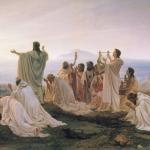 I was delighted to attend the review session of Richard Hays’ new little book Reading Backwards: Figural Christology and the Fourfold Gospel Witness (Baylor, 2014) at SBL. But I was sad that I had not yet gotten a hold of the book – until yesterday when a nice little package arrived. I was eager to dive right in, so I worked through the preface yesterday. Here are some of my notes.
I was delighted to attend the review session of Richard Hays’ new little book Reading Backwards: Figural Christology and the Fourfold Gospel Witness (Baylor, 2014) at SBL. But I was sad that I had not yet gotten a hold of the book – until yesterday when a nice little package arrived. I was eager to dive right in, so I worked through the preface yesterday. Here are some of my notes.
More to come – this is a kind of “progress report” (~150pp) and a deposit on Hays’ study of the Evangelists’ interpretation of Scripture, and Hays is slowly making headway on a much larger, more comprehensive volume.
“Use”? Hays mentions in the preface that his friend Markus Bockmuehl cautioned him against using the language of “use” when it comes to the Evangelists and Scripture. Did they use the OT? Bockmuehl states:
“It seems both a matter of fact and part of the biblical authors’ intent that their engagement with the Old Testament is at least as much a function of the text’s own agency in terms of its (divine) claim and impact on them, rather than merely of their ‘use’ of it. Could one say that they speak as they do because they are thunderstruck by the pressure that Scripture as a hermeneutical Other exerts on their own view of things? In other words, perhaps what seems to the critic as a device or strategy of manipulation may have seemed to the authors mere faithfulness to the divine word’s strong naming of the fresh reality God had worked in their midst” (p. x-xi, Bockmuehl’s personal words to Hays, cited by Hays).
Wow! This statement from Bockmuehl is almost worth the price of the book in itself! Part of the issue is about the business of reading backwards. Were they only reading backwards? Hays is actually on the same page as Bockmuehl, that there is a dialectical relationship between Scripture and new Christo-centric revelation, but this may be obscured a bit by Hays’ title (“reading backwards”). But note Hays’ appreciative nod at Bockmuehl’s statement: “The aim of these lectures [which became the book] is to listen carefully to their acts of narrative witness-bearing and to discern the ways in which their testimony is the product of a catalytic fusion of Israel’s Scripture and the story of Jesus” (p. xi).
Scripture in context. Hays continues to insist that the NT writers (here the Evangelists) interact with the OT with attention to the wider contexts of the “precursor” texts.
No “Q”. Hays very briefly explains his approach to the Synoptic problem – Markan priority, Matthew and Luke dependent on Mark, but no real need for Q (p. xiv).
Is the Christian re-use of OT texts a rejection of Judaism? Tough question, and Hays received many questions on this in the past. Hays holds hope for meaningful dialogue on this, not “us” vs. “them.”
“It is particularly important to see that the sort of figural interpretation practiced by the canonical Evangelists is not a rejection but a retrospective hermeneutical transformation of Israel’s sacred texts” (xv)
Dialogue partners and influences: Hays briefly pays tribute to these dialogue partners (though he does not agree with all of them): Dodd, Lindars, Dahl, Juel, Hans Frei, Joel Marcus, NT Wright, Hurtado, Bauckham, Boyarin, Kavin Rowe.
Inducted in Early High Christology Club (!)
[Carey Newman] has even hospitably initiated me into membership in the Early High Christology Club, even though in the present book I argue that we should stop talking about ‘high’ and ‘low’ Christologiesin the canonical Gospels (xxi).
I agree with Hays on this, and Simon Gathercole, Wright, Kasemann, and Bonhoeffer all have helped me along on this.











